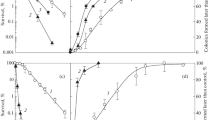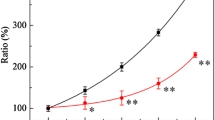Abstract
We have isolated 37 radiation-sensitive mutants of the basidiomyceteCoprinus cinereus. Each mutation is recessive, and the collection defines at least ten complementation groups for survival of gamma irradiation. Four complementation groups define the genesrad3, rad9, rad11 andrad12, which are required both for survival of gamma irradiation and for meiosis. Mutants in each of these four groups fail to complete meiosis and produce mushrooms with greatly reduced numbers of viable spores. Propidium iodide staining of meiotic nuclei showed a characteristic terminal appearance for each mutant: few cells of any of the meiotic mutants progress beyond prophase I, and both condensation and fragmentation or dispersal of meiotic chromatin are frequently observed. Scanning electron micrographs showed that the meiotic mutants make varying numbers (0–6) of basidiospore initials and that few of these initials develop into mature spores. When initials are present they are always symmetrically arrayed on the basidium, regardless of initial number. In quantitative measurements of gamma ray sensitivity, double mutants of every tested combination ofrad3, rad9, rad11 andrad12 consistently showed the same gamma ray sensitivity as the more sensitive single mutant parent of the cross. Therefore, these four genes are in the same pathway for the repair of gamma radiation damage, and this pathway also represents one or more functions essential for meiosis.
Similar content being viewed by others
References
Alani E, Padmore R, Kleckner N (1990) Analysis of wild-type andrad50 mutants of yeast suggests an intimate relationship between meiotic chromosome synapsis and recombination. Cell 61:419–436
Baker BS, Carpenter ATC, Esposito MS, Esposito RE, Sandler L (1976) The genetic control of meiosis. Annu Rev Genet 10:53–134
Baker B, Gatti M, Carpenter ATC, Pimpinelli S, Smith DA (1980) Effects of recombination-deficient and repair-deficient loci on meiotic and mitotic chromosome behavior inDrosophila melanogaster. In: Generoso WM, Shelby MD, deSerres FJ (eds) DNA repair and mutagenesis in eukaryotes, Plenum Publishing Corp, New York, pp 189–208
Bezzubova O, Shinohara A, Mueller RG, Ogawa H, Buerstedde J-M (1993) A chicken RAD51 homologue is expressed at high levels in lymphoid and reproductive organs. Nucleic Acids Res 21:1577–1580
Biedermann KA, Sun JR, Giaccia AJ, Tosto LM, Brown JM (1991)scid mutation in mice confers hypersensitivity to ionizing radiation and a deficiency in DNA double-strand break repair. Proc Natl Acad Sci USA 88:1394–1397
Binninger DM, Skrzynia C, Pukkila PJ, Casselton LA (1987) DNA-mediated transformation of the basidiomyceteCoprinus cinereus. EMBO J 6:835–840
Bishop DK, Park D, Xu L, Kleckner N (1992)DMC1: a meiosisspecific yeast homolog ofE. coli recA required for recombination, synaptonemal complex formation, and cell cycle progression. Cell 69:439–456
Bosma GC, Custer RP, Bosma MJ (1983) A severe combined immunodeficiency mutation in the mouse. Nature 301:527–530
Chang C, Biedermann KA, Mezzina M, Brown JM (1993) Characterization of the DNA double strand break repair defect in scid mice. Cancer Res 53:1244–1248
Cheng R, Baker TI, Cords CE, Radloff RJ (1993)mei-3, a recombination and repair gene ofNeurospora crassa, encodes a RecA-like protein. Mutat Res 294:223–234
Day PR (1959) A cytoplasmically controlled abnormality of the tetrads ofCoprinus lagopus. Heredity 13:81–87
Feaver WJ, Svejstrup JQ, Bardwell L, Bardwell AJ, Buratowski S, Gulyas KD, Donahue TF, Friedberg EC, Kornberg RD (1993) Dual roles of a multiprotein complex fromS. cerevisiae in transcription and DNA repair. Cell 75:1379–1387
Game JC (1983) Radiation-sensitive mutants and repair in yeast. In: Spencer JFT, Spencer DM, Smith ARW (eds) Yeast genetics: fundamental and applied aspects. Springer-Verlag, New York, pp 109–137
Game JC (1992) Pulsed-field gel analysis of the pattern of DNA double-strand breaks in theSaccharomyces genome during meiosis. Dev Genet 13:485–497
Game JC (1993) DNA double-strand breaks and theRAD50−RAD57 genes inSaccharomyces. Semin Cancer Biol 4:73–83
Game JC, Mortimer RK (1974) A genetic study of X-ray sensitive mutants in yeast. Mutat Res 24:281–292
Golubovskaya IN (1989) Meiosis in maize:mei genes and conception of genetic control of meiosis. Adv Genet 26:149–192
Gull K, Newsam RJ (1976) Meiosis in the basidiomycetous fungus,Coprinus atramentarius. Protoplasma 90:343–352
Hasebe K, Murakami S, Tsuneda A (1991) Cytology and genetics of a sporeless mutant ofLentinus edodes. Mycologia 83:354–359
Hendrickson EA, Schatz DG, Weaver DT (1988) Thescid gene encodes atrans-acting factor that mediates the rejoining event of Ig gene rearrangement. Genes Dev 2:817–829
Hendrickson EA, Qin XQ, Bump EA, Schatz DG, Oettinger M, Weaver DT (1991) A link between double-strand break-related repair and V(D)J recombination: the scid mutation. Proc Natl Acad Sci USA 88:4061–4065
Herskowitz I, Rine J, Strathern J (1992) Mating-type determination and mating-type interconversion inSaccharomyces cerevisiae. In: Jones EW, Broach JR, Pringle JR (eds) The molecular and cellular biology of the yeast Saccharomyces: gene expression. Cold Spring Harbor Laboratory Press, Cold Spring Harbor, New York, pp 583–656
Holliday R (1967) Altered recombination frequencies in radiation sensitive strains ofUstilago. Mutat Res 4:275–288
Kanda T, Goto A, Sawa K, Arakawa H, Yasuda Y, Takemaru T (1989) Isolation and characterization of recessive sporeless mutants in the basidiomyceteCoprinus cinereus. Mol Gen Genet 216:526–529
Kerrigan RW, Ross IK (1987) Dynamic aspects of basidiospore number inAgaricus. Mycologia 79:204–215
King HB, Casselton LA (1977) Genetics and function of isocitrate lyase inCoprinus. Mol Gen Genet 157:319–325
Kleckner N, Padmore R, Bishop DK (1991) Meiotic chromosome metabolism: one view. Cold Spring Harbor Symp Quant Biol 56:729–743
Lane DP (1992) p53, guardian of the genome. Nature 358:15–16
McLaughlin DJ (1982) Ultrastructure and cytochemistry of basidial and basidiospore development. In: Wells K, Wells EK (eds) Basidium and basidiocarp. Springer-Verlag, New York, pp 37–74
Moens PB (1994) Molecular perspectives of chromosome pairing at meiosis. Bioessays 16:101–106
Moore D, Pukkila PJ (1985)Coprinus cinereus: an ideal organism for studies of genetics and developmental biology. J Biol Educ 19:31–40
Muris DFR, Vreeken K, Carr AM, Broughton BC, Lehmann AR, Lohman PHM, Pastink A (1993) Cloning theRAD51 homologue ofSchizosaccharomyces pombe. Nucleic Acids Res 21:4586–4591
Ostermann K, Lorentz A, Schmidt H (1993) The fission yeastrad22 gene, having a function in mating-type switching and repair of DNA damages, encodes a protein homolog to Rad52 ofSaccharomyces cerevisiae. Nucleic Acids Res 21:5940–5944
Pearson PL, Ellis JD, Evans HJ (1970) A gross reduction in chiasma formation during meiotic prophase and a defective DNA repair mechanism associated with a case of human male infertility. Cytogenetics 9:460–7
Petes TD, Malone RE, Symington LS (1991) Recombination in yeast. In: Broach JR, Pringle JR, Jones EW (eds) The molecular and cellular biology of the yeast Saccharomyces: genome dynamics, protein synthesis, and energetics. Cold Spring Harbor Laboratory Press, Cold Spring Harbor, New York, pp 407–521
Pukkila PJ (1994) Meiosis in mycelial fungi. In: Wessels JGH, Meinhardt F (eds) The Mycota. vol I, growth, differentiation and sexuality. Springer-Verlag, Berlin Heidelberg, pp 267–281
Pukkila PJ, Casselton LA (1991) Molecular genetics of the agaricCoprinus cinereus. In: Bennett JW, Lasure LL (eds) More gene manipulations in fungi. Academic Press, San Diego, pp 126–150
Pukkila PJ, Lu BC (1985) Silver staining of meiotic chromosomes in the fungus,Coprinus cinereus. Chromosoma 91:108–112
Pukkila PJ, Yashar BM, Binninger DM (1984) Analysis of meiotic development inCoprinus cinereus. In: Evans CW, Dickinson HG (eds) Controlling events in meiosis. Society for Experimental Biology, Cambridge, pp 177–194
Pukkila PJ, Skrzynia C, Lu BC (1992) Therad3-1 mutant is defective in axial core assembly and homologous chromosome pairing during meiosis in the basidiomyceteCoprinus cinereus. Dev Genet 13:403–410
Raju NB (1992) Genetic control of the sexual cycle inNeurospora. Mycol Res 96:241–262
Rao PS, Niederpruem DJ (1969) Carbohydrate metabolism during morphogenesis ofCoprinus lagopus (sensu Buller). J Bacteriol 100:1222–1228
Resnick MA (1969) Genetic control of radiation sensitivity inSaccharomyces cerevisiae. Genetics 62:519–531
Resnick MA (1987) Investigating the genetic control of biochemical events in meiotic recombination. In: Moens PB (eds) Meiosis. Academic Press, Orlando, pp 157–210
Sambrook J, Fritsch EF, Maniatis T (1989) Molecular cloning: a laboratory manual. Cold Spring Harbor Laboratory Press, Cold Spring Harbor, New York
Schuler W, Weiler IJ, Schuler A, Phillips RA, Rosenberg N, Mak TW, Kearney JF, Perry RP, Bosma MJ (1986) Rearrangement of antigen receptor genes is defective in mice with severe combined immune deficiency. Cell 46:963–972
Shinohara A, Ogawa H, Ogawa T (1992) Rad51 protein involved in repair and recombination inS. cerevisiae is arecA-like protein. Cell 69:457–470
Shinohara A, Ogawa H, Matsuda Y, Ushio N, Ikeo K, Ogawa T (1993) Cloning of human, mouse and fission yeast recombination genes homologous toRAD51 andrecA. Nature Genet 4:239–243
Siede W, Friedberg AS, Friedberg EC (1993) RAD9-dependent G2 arrest defines a second checkpoint for damaged DNA in the cell cycle ofSaccharomyces cerevisiae. Proc Natl Acad Sci USA 90:7985–7989
Staiger CJ, Cande WZ (1993) The dominant meiotic mutation,Mei025, uncouples the microtubule cycle from the chromosome cycle. Maydica 38:121–126
Sweder KS, Hanawalt PC (1993) Transcription-coupled DNA repair. Science 262:439
Tani K, Kuroiwa T, Takemaru T (1977) Cytological studies on sporeless mutant in the basidiomyceteCoprinus macrorhizus. Bot Mag Tokyo 90:235–245
Thielke C (1982) Meiotic divisions in the basidium. In: Wells K, Wells EK (eds) Basidium and basidiocarp. Springer-Verlag, New York, pp 75–91
Weber L, Byers B (1992) ARAD9-dependent checkpoint blocks meiosis ofcdc13 yeast cells. Science 131:55–63
Weinert TA, Hartwell LH (1988) TheRAD9 gene controls the cell cycle response to DNA damage inSaccharomyces cerevisiae. Science 241:317–322
Wu MMJ, Cassidy JR, Pukkila PJ (1983) Polymorphisms in DNA ofCoprinus cinereus. Curr Genet 7:385–392
Zolan ME, Tremeel CJ, Pukkila PJ (1988) Production and characterization of radiation-sensitive meiotic mutants ofCoprinus cinereus. Genetics 120:379–387
Zolan ME, Crittenden JR, Heyler NK, Seitz LC (1992) Efficient isolation and mapping ofrad genes of the fungusCoprinus cinereus using chromosome-specific libraries. Nucleic Acids Res 20:3993–3999
Zolan ME, Heyler NK, Ramesh MA (1993) Gene mapping using marker chromosomes inCoprinus cinereus. In: Baltz RH, Hegeman GD, Skatrud PL (eds) Industrial microorganisms: basic and applied molecular genetics. American Society for Microbiology, Washington, pp 31–35
Zolan ME, Heyler NK, Yeager Stassen N (1994) Inheritance of chromosome-length poymorphisms inCoprinus cinereus. Genetics 137:87–94
Zolan ME, Yeager Stassen N, Ramesh MA, Valentine G (1995) Meiotic mutants and DNA repair genes ofCoprinus cinereus. Can J Bot (in press)
Author information
Authors and Affiliations
Additional information
Communicated by B. Judd
Rights and permissions
About this article
Cite this article
Valentine, G., Wallace, Y.J., Turner, F.R. et al. Pathway analysis of radiation-sensitive meiotic mutants ofCoprinus cinereus . Molec. Gen. Genet. 247, 169–179 (1995). https://doi.org/10.1007/BF00705647
Received:
Accepted:
Issue Date:
DOI: https://doi.org/10.1007/BF00705647




